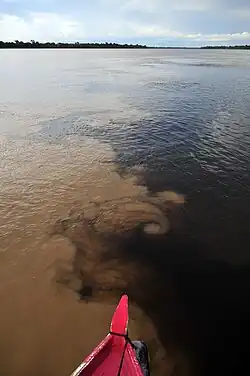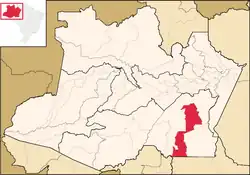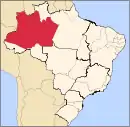Novo Aripuanã | |
|---|---|
Municipality | |
 The confluence of the Madeira River (brown) and Aripuanã River (dark) near Novo Aripuanã. | |
 Flag  Seal | |
 Amazonas state with Novo Aripuanã municipality in red | |
| Coordinates: 5°07′17″S 60°22′50″W / 5.12139°S 60.38056°W | |
| Country | |
| Region | North |
| State | Amazonas |
| Area | |
| • Total | 41,191 km2 (15,904 sq mi) |
| Population (2020) | |
| • Total | 26,046 |
| Time zone | UTC−4 (AMT) |
Novo Aripuanã is a municipality located in the Brazilian state of Amazonas.
History
The region was originally inhabited by the Toras, Barés, Muras, Urupás, Araras and other indigenous peoples. The first records of European penetration to the Madeira River are from 1637, when Pedro Teixeira travelled from Belém to Quito in Ecuador.[1] The municipality of Novo Aripuanã was created by state law 96 of 19 December 1955 from parts of the municipalities of Borba and Manicoré. It contained the district of Foz do Aripuanã with the sub-districts of Alvorada, Manicorezinho and Itapinima, and the district of Sumaúma with the sub-districts of Alvorada, Manicorezinho and Itapinima.[1] The town of Foz do Aripuanã was elevated to the status of a city, named Novo Aripuanã. The first prefect of the municipality, Wilson Paula de Sá, took office on 10 February 1956.[1]
Geography
Location
Novo Aripuanã has an area of 41.191 square kilometres (15.904 sq mi). The population as of 2020 was 26,046.[2] The seat of the municipality is located where the Aripuanã River merges into the Madeira River.
Conservation
The municipality contains 8% of the 2,467,244 hectares (6,096,690 acres) Apuí Mosaic, a jointly-managed collection of conservation units.[3] It contains the 83,381 hectares (206,040 acres) Manicoré State Forest, a sustainable use conservation unit created in 2005.[4] It contains 39% of the 283,117 hectares (699,600 acres) Rio Madeira Sustainable Development Reserve, created in 2006.[5] It contains the 589,611 hectares (1,456,960 acres) Juma Sustainable Development Reserve, created in 2006 to support sustainable extraction of forest resources by the traditional population.[6] It contains 67% of the Campos Amazônicos National Park, a 961,318 hectares (2,375,470 acres) protected area created in 2006 that protects an unusual enclave of cerrado vegetation in the Amazon rainforest.[7] It contains the 72,296 hectares (178,650 acres) Guariba State Park, created in 2005.[8] It contains 28% of the 150,465 hectares (371,810 acres) Guariba Extractive Reserve, also created in 2005.[9]
The municipality contains about 45% of the 359,138 hectares (887,450 acres) Manicoré Biological Reserve, created by decree in May 2016 in the week before the provisional removal of president Dilma Rousseff.[10] It also contains 29% of the 896,411 hectares (2,215,080 acres) Acari National Park, which was created at the same time.[11] The municipality contains about 74% of the 751,302 hectares (1,856,510 acres) Aripuanã National Forest, a sustainable development unit also created at that time.[12]
References
- 1 2 3 Novo Aripuanã, Amazonas - AM: Histórico – IBGE.
- ↑ IBGE 2020
- ↑ MOS do Apuí – ISA, Informações gerais.
- ↑ FES de Manicoré – ISA, Informações gerais.
- ↑ RDS do Rio Madeira – ISA.
- ↑ RDS do Juma – ISA.
- ↑ PARNA dos Campos Amazônicos – ISA.
- ↑ PES do Guariba – ISA, Informações gerais.
- ↑ RESEX do Guariba – ISA, Informações gerais.
- ↑ REBIO do Manicoré – ISA.
- ↑ PARNA do Acari – ISA.
- ↑ FLONA do Aripuanã – ISA.
Sources
- FES de Manicoré (in Portuguese), ISA: Instituto Socioambiental, retrieved 2016-07-12
- FLONA do Aripuanã (in Portuguese), ISA: Instituto Socioambiental, retrieved 2016-06-15
- MOS do Apuí (in Portuguese), ISA: Instituto Socioambiental, retrieved 2016-07-13
- Novo Aripuanã, Amazonas - AM: Histórico (PDF) (in Portuguese), IBGE: Instituto Brasileiro de Geografia e Estatística, retrieved 2016-06-15
- PARNA do Acari (in Portuguese), ISA: Instituto Socioambiental, retrieved 2016-06-12
- PARNA dos Campos Amazônicos (in Portuguese), ISA: Instituto Socioambiental, retrieved 2016-06-03
- PES do Guariba (in Portuguese), ISA:Instituto Socioambiental, retrieved 2016-07-23
- RDS do Juma (in Portuguese), ISA: Instituto Socioambiental, retrieved 2016-06-15
- REBIO do Manicoré (in Portuguese), ISA: Instituto Socioambiental, retrieved 2016-06-14
- RDS do Rio Madeira (in Portuguese), ISA: Instituto Socioambiental, retrieved 2016-09-01
- RESEX do Guariba (in Portuguese), ISA: Instituto Socioambiental, retrieved 2016-07-24
